Multiband Photogrammetry and Hybrid Image Analysis for the Investigation of a Wall Painting by Paolo de San Leocadio and Francesco Pagano in the Cathedral of Valencia
Abstract
1. Introduction
2. Materials and Methods
2.1. The Case Study
2.2. Data Acquisition
- 76 multiband images were acquired by using a Fujifilm IS Pro digital single lens reflect (DSLR) camera (Figure 2a), modified ex-stock as ultraviolet (UV), visible (VIS) and near-infrared (NIR) sensitive. Hereby sets of 19 images of UV-R_UV, VIS-R_VIS and two IR-R_IR were taken;
- 17 wide-angle images were taken using a Canon EOS 5D Mark II DSLR (Figure 2b). These images form the basic photogrammetric survey supporting the orientation of the MBI data;
- 3 terrestrial laser scans serving as ground truth measurements for scaling and correct orientation of the image data were used. The TLS data were acquired by using a Trimble TX6 (Figure 2c).
2.2.1. Multiband Image Acquisition
2.2.2. Photogrammetric Image Acquisition
2.2.3. TLS Data Acquisition
2.3. Data Processing
2.3.1. Processing TLS data
2.3.2. Pre-Processing Image Data
2.3.3. Photogrammetric Data Processing
- Internal camera orientation (all images: MBI and colour);
- Relative external orientation and tie point extraction (all images: MBI and colour);
- Absolute external camera orientation (all images: MBI and colour), using CPs and evaluation using ChPs; root mean square error (RMSE) is shown in Table 5;
- Generation of a dense point cloud (only colour images);
- Generation of a 3D model (only colour images);
- Texturisation of the 3D model (separate for each spectral band: UV-R_UV, VIS-R_VIS, 2x IR-R_IR). To avoid image compression during texturisation, a TIFF-based texture mapping was chosen.
- 1st line: pixel size in metres for the X-axis;
- 2nd line: image rotation around the Y-axis;
- 3rd line: image rotation around the X-axis;
- 4th line: pixel size in metres for the Y-axis (negative value);
- 5th line: X-coordinate for the upper left pixel;
- 6th line: Y-coordinate of the upper left pixel.
3. Results
3.1. Hybrid Image Processing and Image Analysis
3.1.1. False Colour Images
3.1.2. Principal Component Analysis (PCA)
3.1.3. NDVI/NDPI
3.2. Combination in GIS
4. Discussion
5. Conclusions
Author Contributions
Funding
Institutional Review Board Statement
Informed Consent Statement
Data Availability Statement
Acknowledgments
Conflicts of Interest
References
- Picollo, M.; Stols-Witlox, M.; Fuster Lopez, L. (Eds.) Introduction to the Volume. In UV-Vis Luminescence Imaging Techniques/Técnicas de Imagen de Luminiscencia UV-Vis; Editorial Universitat Politècnica de València: Valencia, Spain, 2019; pp. 11–18. [Google Scholar]
- Qureshi, R.; Uzair, M.; Khurshid, K.; Yan, H. Hyperspectral Document Image Processing: Applications, Challenges and Future Prospects. Pattern Recognit. 2019, 90, 12–22. [Google Scholar] [CrossRef]
- Jones, C.; Duffy, C.; Gibson, A.; Terras, M. Understanding Multispectral Imaging of Cultural Heritage: Determining Best Practice in MSI Analysis of Historical Artefacts. J. Cult. Herit. 2020, 45, 339–350. [Google Scholar] [CrossRef]
- Cucci, C.; Picollo, M.; Chiarantini, L.; Uda, G.; Fiori, L.; De Nigris, B.; Osanna, M. Remote-Sensing Hyperspectral Imaging for Applications in Archaeological Areas: Non-Invasive Investigations on Wall Paintings and on Mural Inscriptions in the Pompeii Site. Microchem. J. 2020, 158, 105082. [Google Scholar] [CrossRef]
- Cucci, C.; Bracci, S.; Casini, A.; Innocenti, S.; Picollo, M.; Stefani, L.; Rao, I.G.; Scudieri, M. The Illuminated Manuscript Corale 43 and Its Attribution to Beato Angelico: Non-Invasive Analysis by FORS, XRF and Hyperspectral Imaging Techniques. Microchem. J. 2018, 138, 45–57. [Google Scholar] [CrossRef]
- Amigo, J.M. Hyperspectral and Multispectral Imaging: Setting the Scene. Data Handl. Sci. Technol. 2020, 32, 3–16. [Google Scholar] [CrossRef]
- Amigo, J.M.; Grassi, S. Configuration of Hyperspectral and Multispectral Imaging Systems. Data Handl. Sci. Technol. 2020, 32, 17–34. [Google Scholar] [CrossRef]
- Pelagotti, A.; Mastio, A.D.; De Rosa, A.; Piva, A. Multispectral Imaging of Paintings: A Way to Material Identification. IEEE Signal Process. Mag. 2008, 25, 27–36. [Google Scholar] [CrossRef]
- Herrero-Cortell, M.A.; Creus, M.R.; Artoni, P.; Puig, I. Multi-Band Technical Imaging in the Research of the Execution of Paintings. The Case Study of the Portrait of Carlos IV, by Francisco de Goya. Ge-Conservacion 2018, 1, 5–15. [Google Scholar] [CrossRef]
- Dyer, J.; Verri, G.; Cupitt, J. Multispectral Imaging in Reflectance and Photo-Induced Luminescence Modes: A User Manual; The British Museum: London, UK, 2013. [Google Scholar]
- Cosentino, A.; Gil, M.; Ribeiro, M.; Di Mauro, R. Technical Photography for Mural Paintings: The Newly Discovered Frescoes in Aci Sant’Antonio (Sicily, Italy). Conserv. Patrim. 2014, 20, 23–33. [Google Scholar] [CrossRef]
- Keller, A.T.; Lenz, R.; Artesani, A.; Mosca, S.; Comelli, D.; Nevin, A. Exploring the Ultraviolet Induced Infrared Luminescence of Titanium White Pigments Explorando La Luminiscencia Infrarroja Inducida Por Ultravioleta de Pigmentos Blancos de Titanio. In UV-Vis Luminescence Imaging Techniques/Técnicas de Imagen de Luminiscencia UV-Vis; Picollo, M., Stols-Witlox, M., Fuster-López, L., Eds.; Editorial Universitat Politècnica de València: Valencia, Spain, 2019; pp. 201–232. [Google Scholar]
- Keller, A.T.; Lenz, R. Reflexion, Absorption Und Lumineszenz—Strahlendiagnostische Phänomene Zu Kompositionellen, Maltechnischen Und Materialspezifischen Fragestellungen Am Wandbild in Der Vorhalle Des Bischofstores Im Wiener Stephansdom. Osterr. Z. Für Kunst Denkmalpfl. 2021, 1, 153–162. [Google Scholar]
- Cavallo, G.; Aceto, M.; Emmenegger, R.; Keller, A.T.; Lenz, R.; Villa, L.; Wörz, S.; Cassitti, P. Preliminary Non-Invasive Study of Carolingian Pigments in the Churches of St. John at Müstair and St. Benedict at Malles. Archaeol. Anthropol. Sci. 2020, 12, 73. [Google Scholar] [CrossRef]
- Cosentino, A. Identification of Pigments by Multispectral Imaging; a Flowchart Method. Herit. Sci. 2014, 2, 8. [Google Scholar] [CrossRef]
- Verhoeven, G. Methodes of Visualisation. In Analytical Archeometry, Selected Topics; Edwards, H.G.M., Vandenabeele, P., Eds.; Royal Society of Chemistry Publishing: Cambridge, UK; London, UK, 2012; pp. 3–48. [Google Scholar] [CrossRef]
- Webb, E.K.; Robson, S.; MacDonald, L.; Garside, D.; Evans, R. Spectral and 3D Cultural Heritage Documentation Using a Modified Camera. Int. Arch. Photogramm. Remote Sens. Spat. Inf. Sci. ISPRS Arch. 2018, 42, 1183–1190. [Google Scholar] [CrossRef]
- Bläuer, C.; Keller, A.T. Mainly Red and a Hidden Blue—Laboratory and MSI Investigations on the Carolingian Wall Paintings in the Chapel of the Holy Cross of Müstair (Switzerland). J. Cult. Herit. 2020, 42, 72–80. [Google Scholar] [CrossRef]
- Sfarra, S.; Ibarra-Castanedo, C.; Ambrosini, D.; Paoletti, D.; Bendada, A.; Maldague, X. Discovering the Defects in Paintings Using Non-Destructive Testing (NDT) Techniques and Passing through Measurements of Deformation. J. Nondestruct. Eval. 2014, 33, 358–383. [Google Scholar] [CrossRef]
- Lang, V.; Lenz, R. Einiges Über Die Farbe …“ Zur Wandmalereitechnik von Adolf Hölzel. In Mit Religion Kann Man Nicht Malen. Adolf Hölzel in Ulm; Landesamt für Denkmalpflege im Regierungspräsidium Stuttgart, Ed.; Landesamt für Denkmalpflege im Regierungspräsidium Stuttgart: Esslingen, Germany, 2017; pp. 74–97. [Google Scholar]
- van Asperen de Boer, J.R.J. Infrared Reflectography: A Method for the Examination of Paintings. Appl. Opt. 1968, 7, 1711. [Google Scholar] [CrossRef]
- Van Asperen De Boer, J.R.J. Reflectography of Paintings Using an Infrared Vidicon Television System. Stud. Conserv. 1969, 14, 96–118. [Google Scholar] [CrossRef]
- Warda, J.; Frey, F.; Heller, D.; Kushel, D.; Vitale, T.; Weaver, G. The AIC Guide to Digital Photography and Conservation Documentation, 2nd ed.; American Institute for Conservation: Washington, DC, USA, 2011. [Google Scholar]
- Webb, E.K. Reflected Infrared Imaging Revisiting the Fundamentals. In Proceedings of the 2015 Digital Heritage International Congress, Granada, Spain, 28 September–2 October 2015; pp. 51–54. [Google Scholar] [CrossRef]
- Daveri, A.; Vagnini, M.; Nucera, F.; Azzarelli, M.; Romani, A.; Clementi, C. Visible-Induced Luminescence Imaging: A User-Friendly Method Based on a System of Interchangeable and Tunable LED Light Sources. Microchem. J. 2016, 125, 130–141. [Google Scholar] [CrossRef]
- Dyer, J.; Sotiropoulou, S. A Technical Step Forward in the Integration of Visible-Induced Luminescence Imaging Methods for the Study of Ancient Polychromy. Herit. Sci. 2017, 5, 1–22. [Google Scholar] [CrossRef]
- Trentelman, K. Analyzing the Heterogeneous Hierarchy of Cultural Heritage Materials: Analytical Imaging. Annu. Rev. Anal. Chem. 2017, 10, 247–270. [Google Scholar] [CrossRef]
- Stylianidids, E.; Georgopoulos, A.; Remondino, F. Basics of Image-Based Modelling Techniques in Cultural Heritage 3D Recording. In 3D Recording, Documentation and Management of Cultural Heritage; Stylianidis, E., Remondino, F., Eds.; Whittles Publishing: Dunbeath, Scotland, 2016; pp. 253–304. [Google Scholar]
- Fischer, C.; Kakoulli, I. Multispectral and Hyperspectral Imaging Technologies in Conservation: Current Research and Potential Applications. Stud. Conserv. 2006, 51, 3–16. [Google Scholar] [CrossRef]
- Liang, H. Advances in Multispectral and Hyperspectral Imaging for Archaeology and Art Conservation. Appl. Phys. A Mater. Sci. Process. 2012, 106, 309–323. [Google Scholar] [CrossRef]
- Conover, D.M.; Delaney, J.K.; Loew, M.H. Automatic Registration and Mosaicking of Technical Images of Old Master Paintings. Appl. Phys. A Mater. Sci. Process. 2015, 119, 1567–1575. [Google Scholar] [CrossRef]
- Cosentino, A. Panoramic, Macro and Micro Multispectral Imaging: An Affordable System for Mapping Pigments on Artworks. J. Conserv. Museum Stud. 2015, 13, 1–17. [Google Scholar] [CrossRef]
- Vandivere, A.; Van Loon, A.; Dooley, K.A.; Haswell, R.; Erdmann, R.G.; Leonhardt, E.; Delaney, J.K. Revealing the Painterly Technique beneath the Surface of Vermeer’s Girl with a Pearl Earring Using Macro-and Microscale Imaging. Herit. Sci. 2019, 7, 64. [Google Scholar] [CrossRef]
- Mathys, A.; Jadinon, R.; Hallot, P. Exploiting 3D Multispectral Texture for a Better Feature Identification for Cultural Heritage. ISPRS Ann. Photogramm. Remote Sens. Spat. Inf. Sci. 2019, 4, 91–97. [Google Scholar] [CrossRef]
- Zainuddin, K.; Majid, Z.; Ariff, M.F.M.; Idris, K.M.; Abbas, M.A.; Darwin, N. 3D modeling for rock art documentation using lightweight multispectral camera. ISPRS Ann. Photogramm. Remote Sens. Spat. Inf. Sci. 2019, 42, 787–793. [Google Scholar] [CrossRef]
- Nocerino, E.; Rieke-Zapp, D.H.; Trinkl, E.; Rosenbauer, R.; Farella, E.M.; Morabito, D.; Remondino, F. Mapping VIS and UVL Imagery on 3D Geometry for Non-Invasive, Non-Contact Analysis of a Vase. Int. Arch. Photogramm. Remote Sens. Spat. Inf. Sci. ISPRS Arch. 2018, 42, 773–780. [Google Scholar] [CrossRef]
- Pamart, A.; Guillon, O.; Faraci, S.; Gattet, E.; Genevois, M.; Vallet, J.M.; De Luca, L. Multispectral Photogrammetric Data Acquisition and Processing for Wall Paintings Studies. Int. Arch. Photogramm. Remote Sens. Spat. Inf. Sci. ISPRS Arch. 2017, 42, 559–566. [Google Scholar] [CrossRef]
- Herrero-Cortell, M.Á. “No Avie En Lo Regne Mestre En Lo Art d ‘affrescar”. Consideraciones Técnicas Sobre La Introducción de La Pintura Al Fresco En El Renacimiento Hispano y Su Impacto En Las Coronas de Castilla y Aragón. Vestir la Arquit. XXII Congr. Nac. Hist. Arte 2019, 1, 649–653. [Google Scholar]
- Company-X (Ed.) Paolo Da San Leocadio i Els Inicis de La Pintura Del Renaixement a Espanya; CEIC Alfons el Vell: Gandia, Spain, 2006. [Google Scholar]
- Herrero-Cortell, M.Á. Las Pinturas Renacentistas Del Altar Mayor de La Catedral de Valencia o La Introducción de La Técnica Ad Affresco En La Corona de Aragón; Una Lectura En Clave Material y Procedimental. In Pintura mural en la Edad Moderna. Entre Andalucía e Iberoamérica; Universidad Pablo de Olavide: Sevilla, Spain, 2018; pp. 30–59. [Google Scholar]
- Artoni, P.; Bertelli, P.; Herrero Cortell, M.À.; Raïch Creus, M. Les Pintures Murals del Torneig-Batalla de Louvezerp, de Pisanello; Edicions i Publicacions de la Universitat de Lleida: Lleida, Spain, 2022. [Google Scholar] [CrossRef]
- Tolosa, L.; Company-X. Apèndix Documental. In Paolo de San Leocadio i els inicis de la pintura del Renaixement a Espanya; Company-X, Ed.; CEIC Alfons el Vell: Gandia, Spain, 2006; pp. 319–414. [Google Scholar]
- Grussenmeyer, P.; Landes, T.; Doneus, M.; Lerma, J.L. Basics of Range-Based Modelling Techniques in Cultural Heritage 3D Recording. In 3D Recording, Documentation and Management of Cultural Heritage; Stylianidids, E., Remondino, F., Eds.; Whittles Publishing: Dunbeath, Scotland, 2016; pp. 305–368. [Google Scholar]
- Verhoeven, G. Basics of Photography for Cultural Heritage Imaging. In 3D Recording, Documentation and Management of Cultural Heritage; Stylianidids, E., Remondino, F., Eds.; Whittles Publishing: Dunbeath, Scotland, 2016; pp. 127–251. [Google Scholar]
- Moon, T.; Schilling, M.; Thirkettle, S. A Note on the Use of False-Color Infrared Photography in Conservation. Stud. Conserv. 1992, 37, 42. [Google Scholar] [CrossRef]
- Aldrovandi, A.; Picollo, M. Metodi di Documentazione e di Indagini Non Invasive Sui Dipinti; Il Prato: Padova, Italy, 2003. [Google Scholar]
- Aguilar-Téllez, D.M.; Ruvalcaba-Sil, J.L.; Claes, P.; González-González, D. False Color and Infrared Imaging for the Identification of Pigments in Paintings. MRS Online Proc. Libr. 2014, 1618, 3–15. [Google Scholar] [CrossRef]
- Raìch, M.; Artoni, P.; Herrero-Cortell, M.A.; La Bella, A.; Ricci, M.L.; Hernandez, A. Riconoscere Dal Colore. Pigmenti e Coloranti Dell’et Moderna Nell’analisi Multibanda Dei Dipinti: Uno Strumento Visivo per Gli Storici DellÕarte e i Conservatori. In Colore e Colorimetria Contributi Multidisciplinari, Vol. XV A; Gruppo del Colore—Associazione Italiana Colore: Milano, Italy, 2019; pp. 120–127. [Google Scholar]
- Domingo, I.; Carrión, B.; Blanco, S.; Lerma, J.L. Evaluating Conventional and Advanced Visible Image Enhancement Solutions to Produce Digital Tracings at El Carche Rock Art Shelter. Digit. Appl. Archaeol. Cult. Herit. 2015, 2, 79–88. [Google Scholar] [CrossRef]
- Marini, F.; Amigo, J.M. Unsupervised Exploration of Hyperspectral and Multispectral Images. Data Handl. Sci. Technol. 2020, 32, 93–114. [Google Scholar] [CrossRef]
- Salerno, E.; Tonazzini, A.; Grifoni, E.; Lorenzetti, G.; Legnaioli, S.; Lezzerini, M.; Marras, L.; Pagnotta, S.; Palleschi, V. Analysis of Multispectral Images in Cultural Heritage and Archaeology. J. Appl. Laser Spectrosc. 2014, 1, 22–27. [Google Scholar]
- Cantó, A.; Lerma, J.L.; Valle, R.M.; Villaverde, V. Multi-Light Photogrammetric Survey Applied to the Complex Documentation of Engravings in Palaeolithic Rock Art: The Cova de Les Meravelles (Gandia, Valencia, Spain). Herit. Sci. 2022, 10, 169. [Google Scholar] [CrossRef]
- Yengoh, G.T.; Dent, D.; Olsson, L.; Tengberg, A.E.; Tucker III, C.J. Use of the Normalized Difference Vegetation Index (NDVI) to Assess Land Degradation at Multiple Scales; Springer: Cham, Switzerland; Heidelberg, Germany; New York, NY, USA; Dordrecht, The Netherlands; London, UK, 2016. [Google Scholar] [CrossRef]
- Rahrig, M.; Drewello, R.; Lazzeri, A. Opto-Technical Monitoring—A Standardized Methodology to Assess the Treatment of Historical Stone Surfaces. Int. Arch. Photogramm. Remote Sens. Spat. Inf. Sci. ISPRS Arch. 2018, 42, 945–952. [Google Scholar] [CrossRef]
- Pettorelli, N.; Vik, J.O.; Mysterud, A.; Gaillard, J.M.; Tucker, C.J.; Stenseth, N.C. Using the Satellite-Derived NDVI to Assess Ecological Responses to Environmental Change. Trends Ecol. Evol. 2005, 20, 503–510. [Google Scholar] [CrossRef]
- Carlson, T.N.; Ripley, D.A. On the Relation between NDVI, Fractional Vegetation Cover, and Leaf Area Index. Remote Sens. Environ. 1997, 62, 241–252. [Google Scholar] [CrossRef]
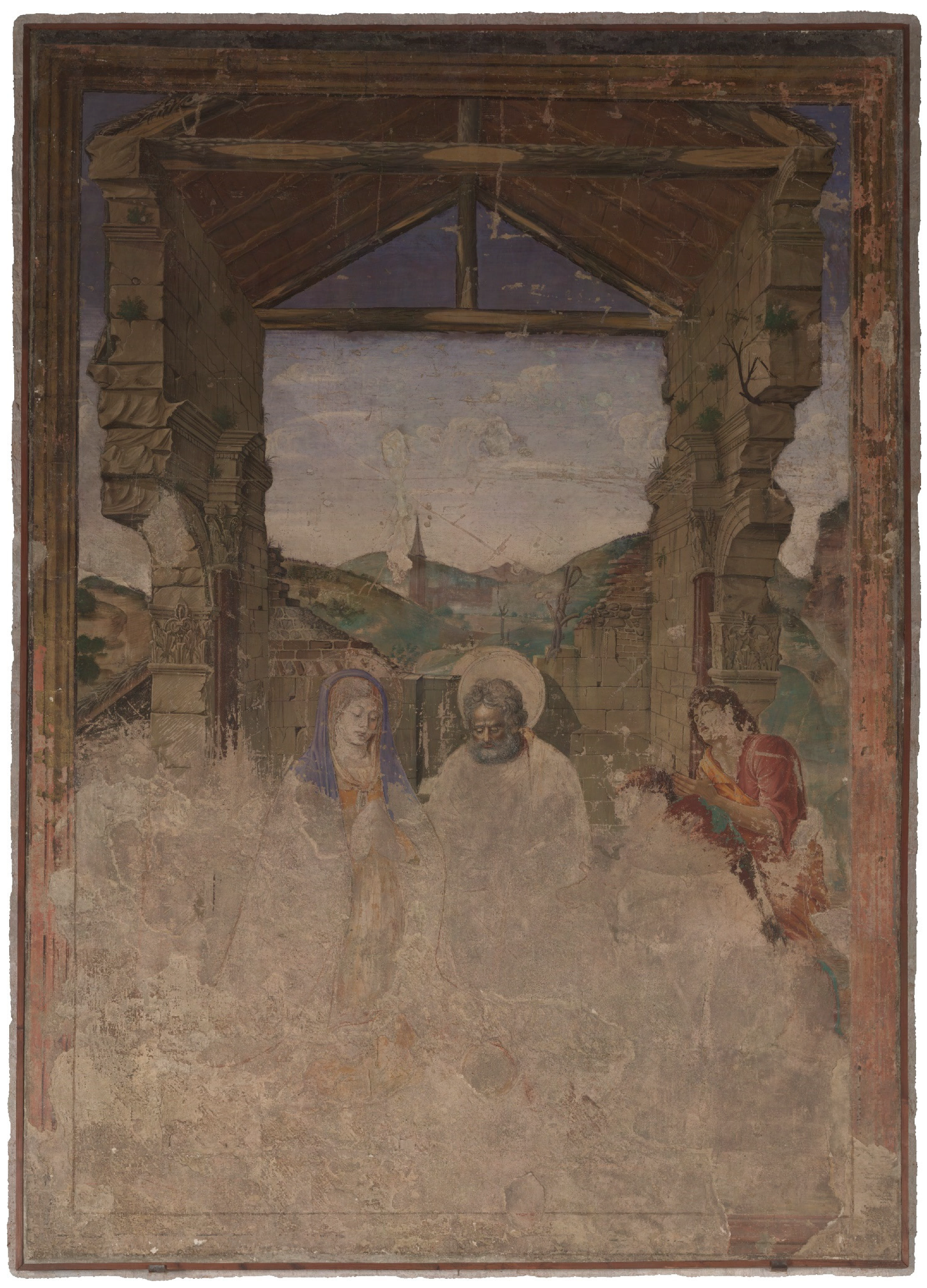

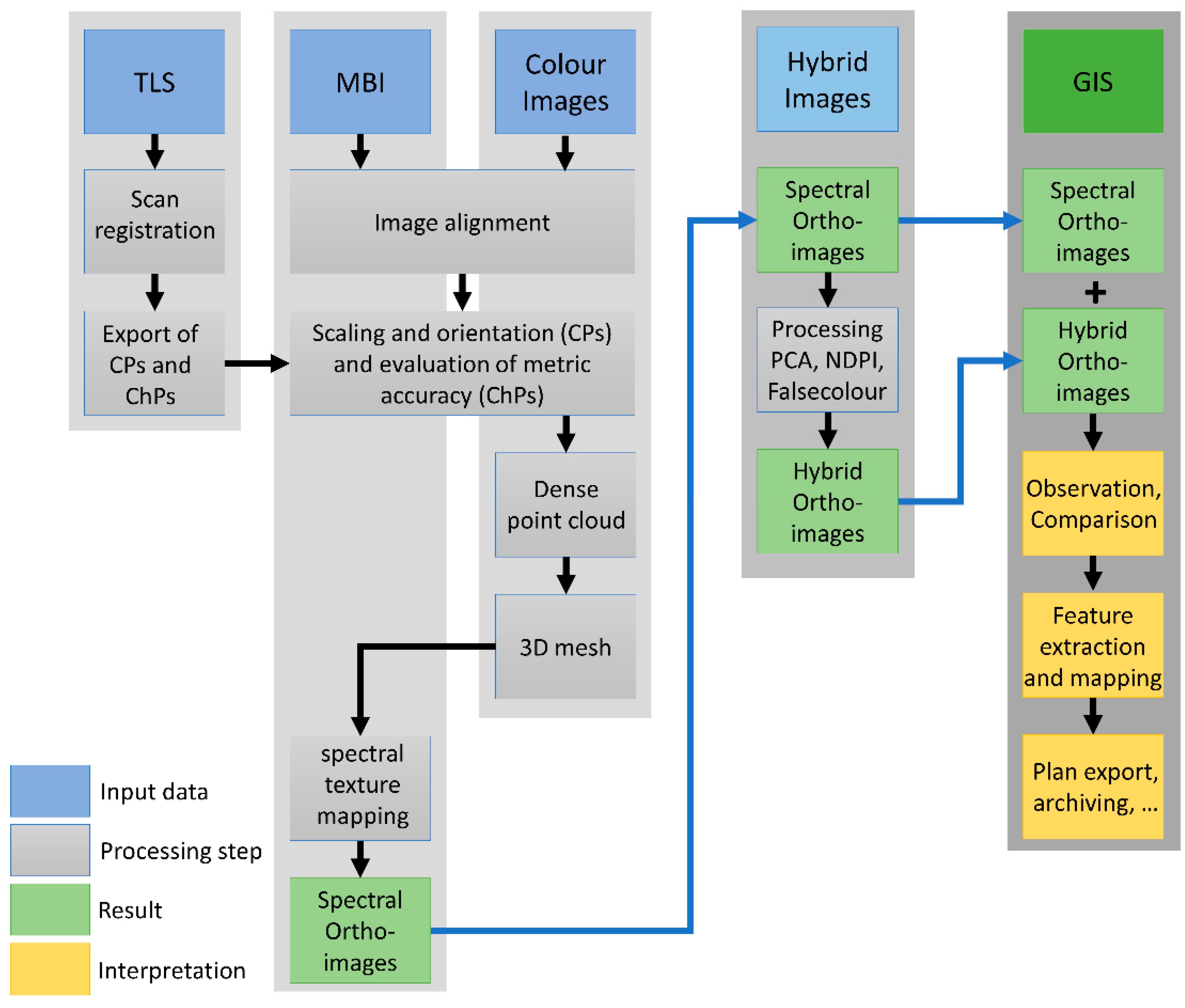


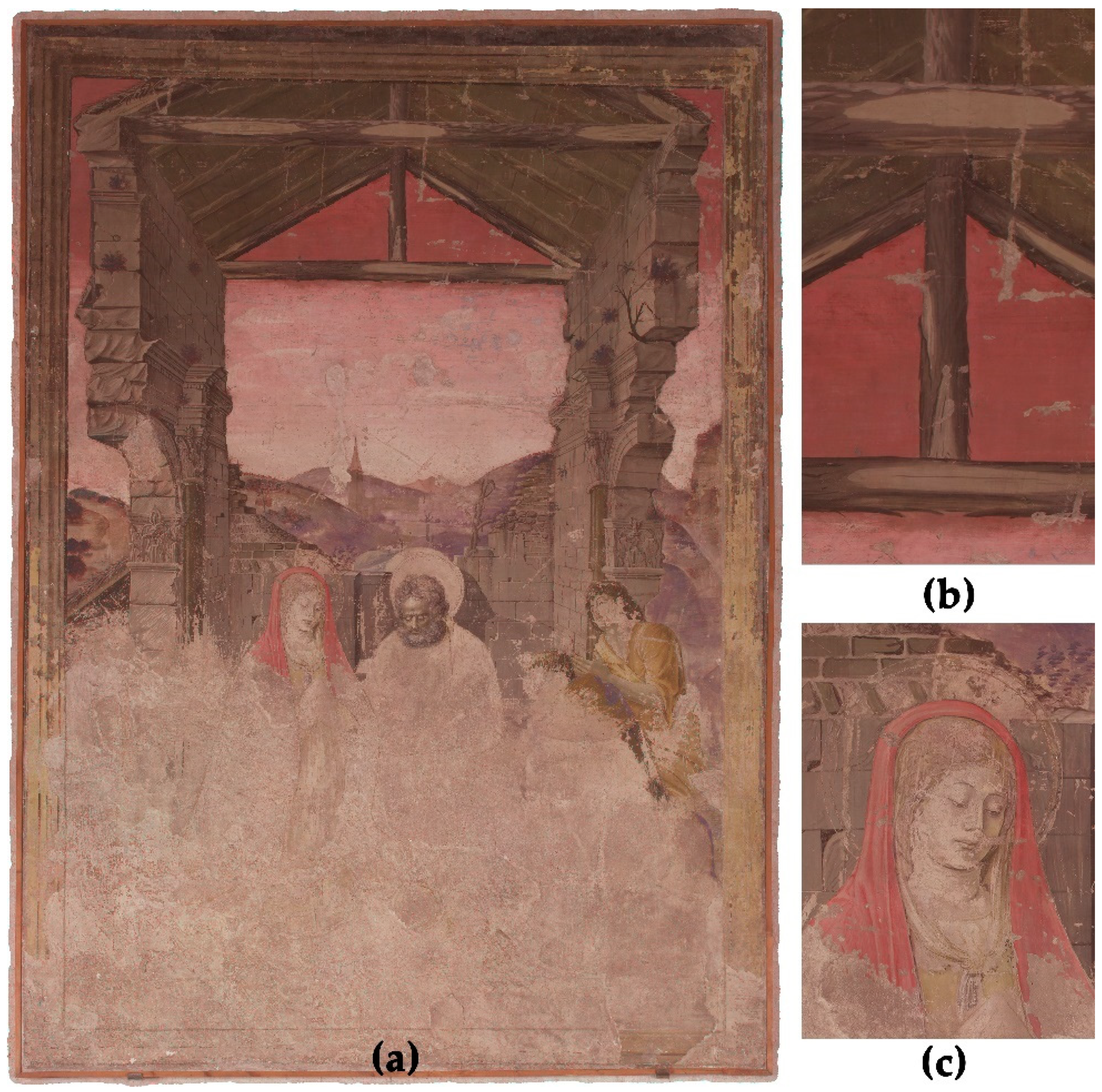

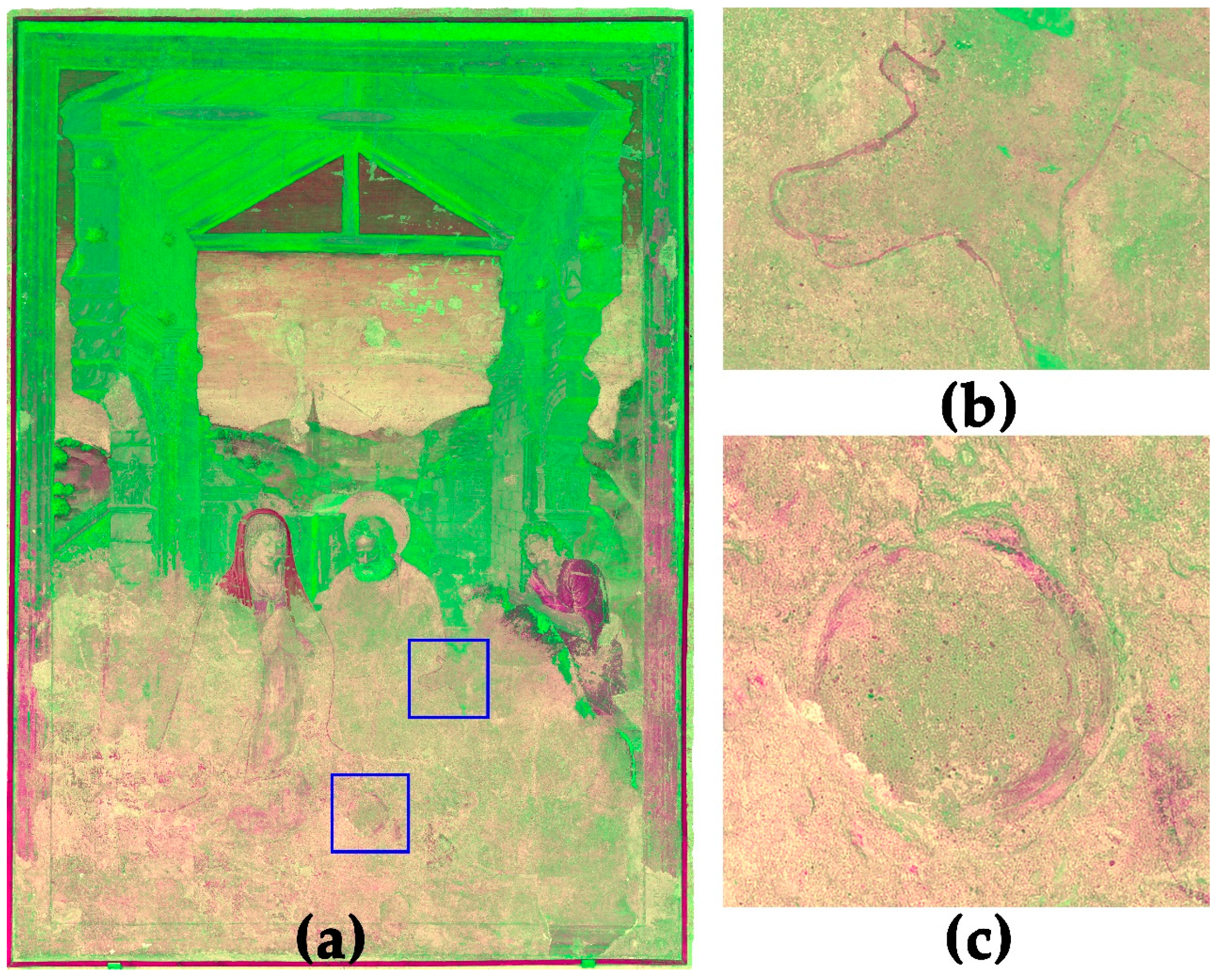
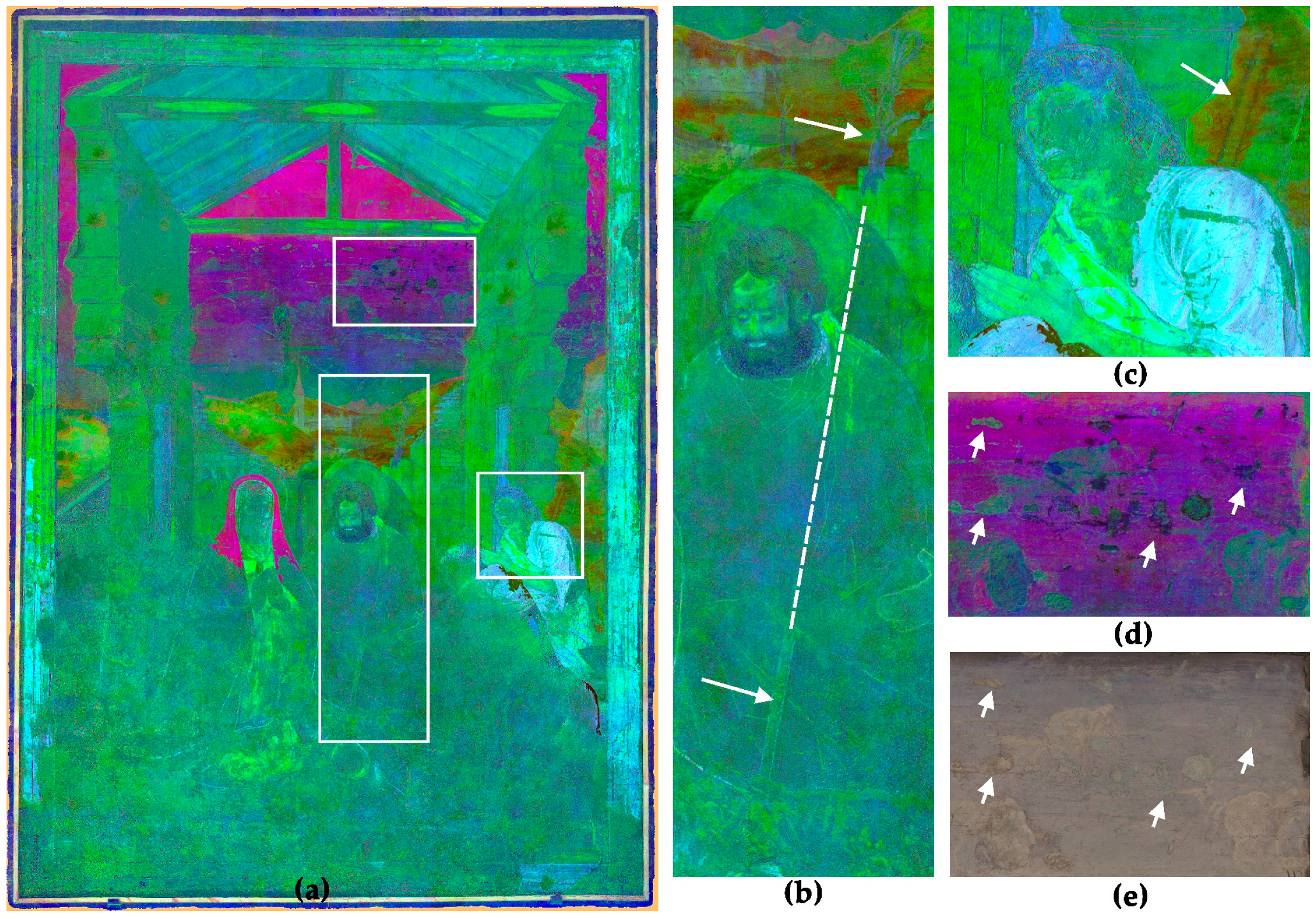

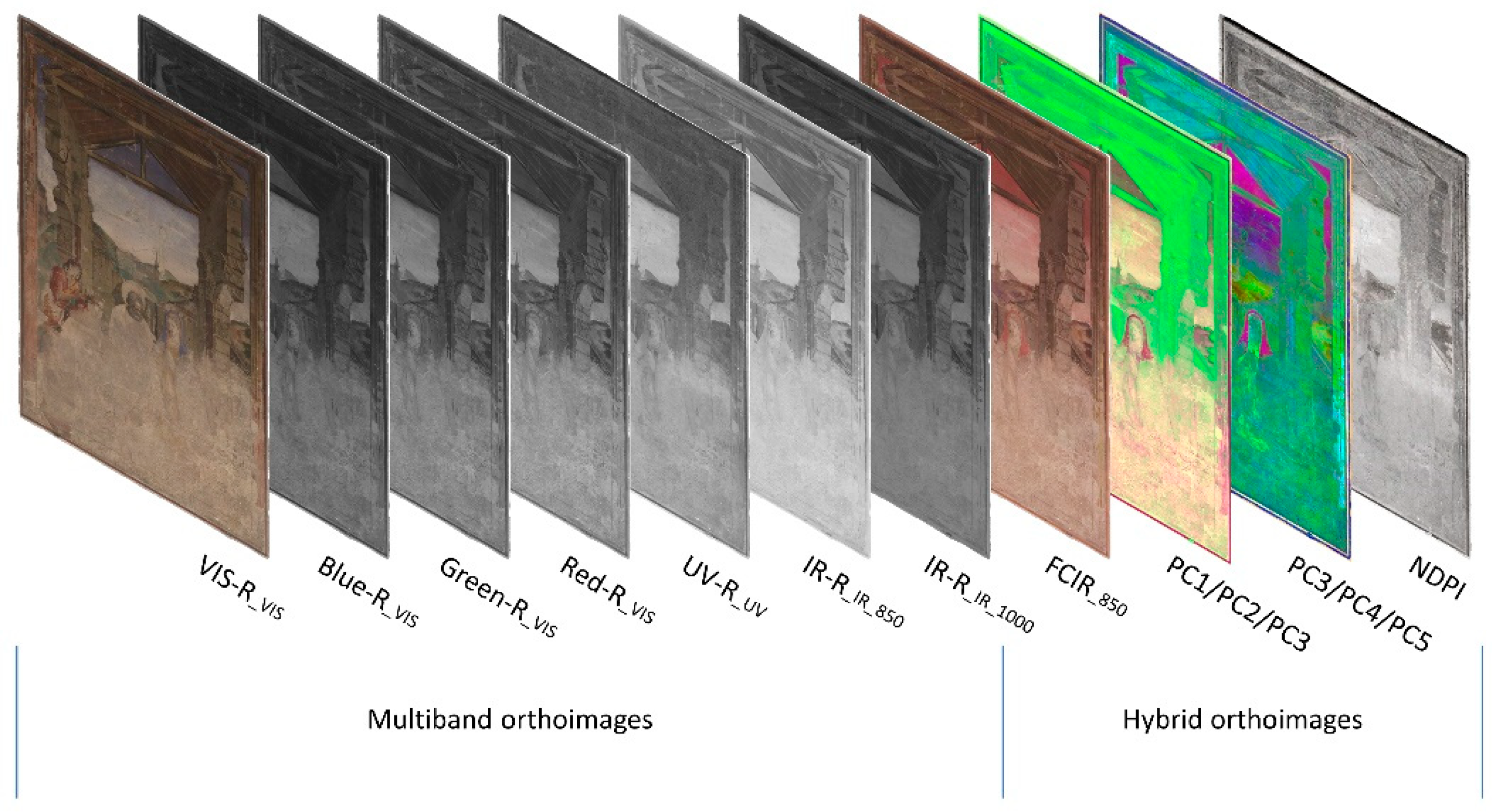
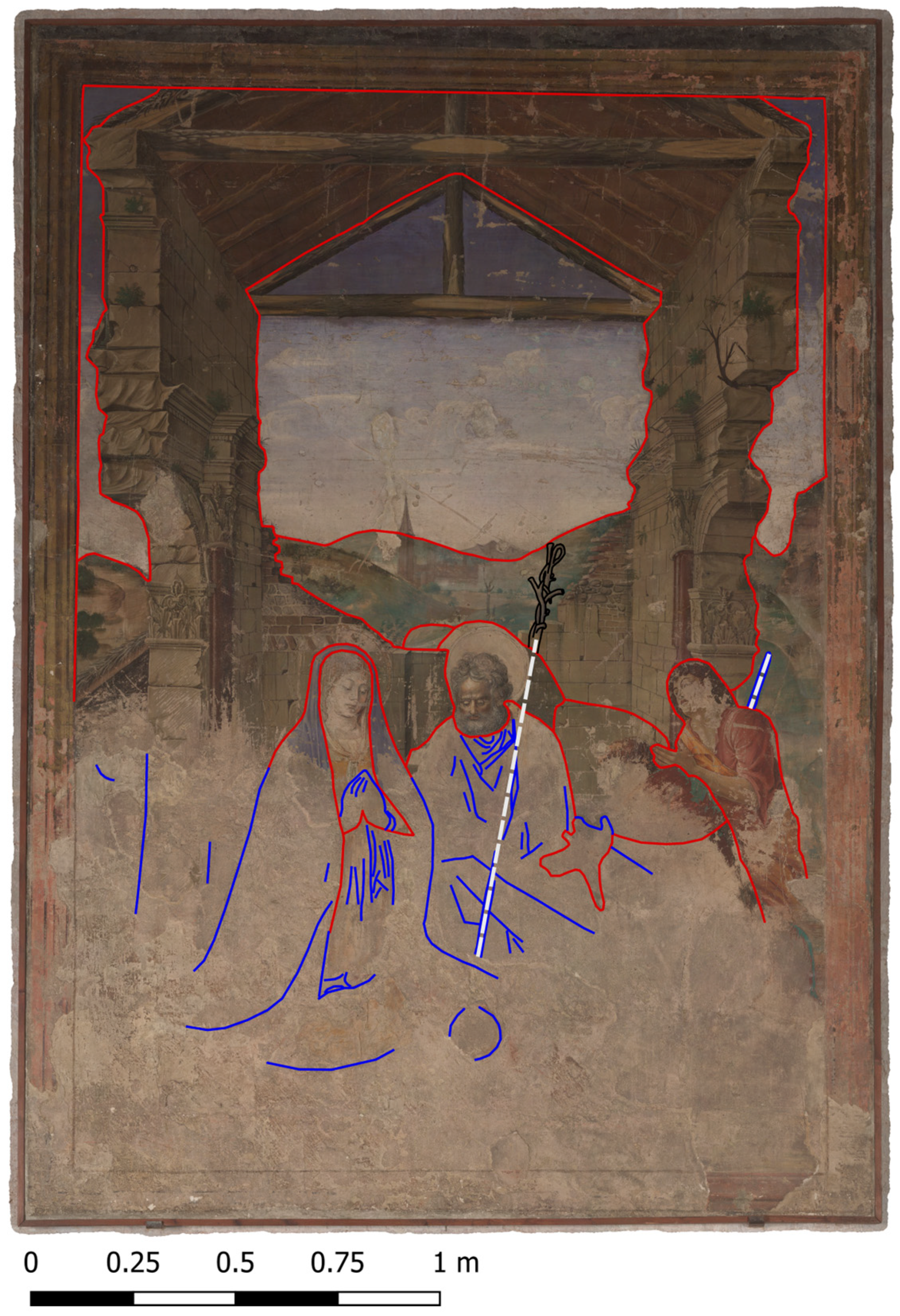
| Abbreviation | Imaging Method | Also Known as | Radiation Source | Filter Sensitivity |
|---|---|---|---|---|
| UV-R_UV | UV-induced UV reflectography | UVR, UV-reflectance imaging | UV (~365 nm), UV-LED, Wood’s lamp | UV band-pass filter (320–390 nm) |
| VIS-L_UV | UV-induced VIS luminescence imaging | UVL, UVF (UV-fluorescence) imaging | UV (~365 nm), UV-LED, Wood’s lamp | UV/IR-cut filter (380–750 nm) |
| VIS-R_VIS | VIS-induced VIS reflectography | VIS, VIS-reflectance imaging, Colour photography | LED, Tungsten, Flash | UV/IR-cut filter (380–750 nm) |
| IR-L_VIS | VIS-induced IR luminescence imaging | VIL, IRF (IR-fluorescence) imaging | VIS 380–750 nm | IR long-pass filter (e.g., starting at 850 nm or 1000 nm) |
| IR-R_IR | IR-induced IR reflectography | IR, IRR (IR-reflectography) imaging | IR (700–1050 nm), LED or undefined light sources with a high amount of IR radiation, e.g., Tungsten, Flash and Halogen lamps | IR long-pass filter (e.g., starting at 850 nm or 1000 nm) |
| Fujifilm IS Pro | Filters | Light Sources | ||||
|---|---|---|---|---|---|---|
| Sensor | Super CCD Pro; 12 Mpix. | UV-R | MidOpt BP365 + MidOpt SP730 | 320–410 nm | 2 UV LEDs | UV-R |
| Sensor size | APS-C; 23 × 15.5 mm | VIS-R | MidOpt BP550 | 405–690 nm | 2 Halogen spotlights | VIS-R + IR-R |
| Image size | 4256 × 2848 pixels | IR-R_850 | MidOpt LP850 | 850–1100 nm | ||
| Lens | CostalOpt. UV-VIS-IR 60 mm Apo Macro | IR-R_1000 | MidOpt LP1000 | 990–1100 nm | ||
| Focal length | 60 mm | |||||
| Canon EOS 5D Mark II | |
|---|---|
| Sensor | CMOS 21.1 Mpx |
| Sensor size | Full frame (36 × 24 mm) |
| Image size | 5616 × 3744 pixels |
| Focal length | 24 mm |
| Trimble TX6 Laser Scanner | |
|---|---|
| Distance measurements | Phase shift |
| Wavelength | 1.5 µm |
| Extended range | 120 m |
| Horizontal and vertical range | 360°/317° |
| Distance accuracy | <2 mm (1 sigma) |
| Acquisition speed | 500,000 pts/s |
| Camera | RGB |
| RMSE (m) | |||||
|---|---|---|---|---|---|
| X (m) | Y (m) | Z (m) | XYZ (m) | Pixel Error | |
| CPs (4) | 0.0042 | 0.0056 | 0.0039 | 0.0080 | 1.902 |
| ChPs (5) | 0.0076 | 0.0072 | 0.0097 | 0.0143 | 3.421 |
Disclaimer/Publisher’s Note: The statements, opinions and data contained in all publications are solely those of the individual author(s) and contributor(s) and not of MDPI and/or the editor(s). MDPI and/or the editor(s) disclaim responsibility for any injury to people or property resulting from any ideas, methods, instructions or products referred to in the content. |
© 2023 by the authors. Licensee MDPI, Basel, Switzerland. This article is an open access article distributed under the terms and conditions of the Creative Commons Attribution (CC BY) license (https://creativecommons.org/licenses/by/4.0/).
Share and Cite
Rahrig, M.; Herrero Cortell, M.Á.; Lerma, J.L. Multiband Photogrammetry and Hybrid Image Analysis for the Investigation of a Wall Painting by Paolo de San Leocadio and Francesco Pagano in the Cathedral of Valencia. Sensors 2023, 23, 2301. https://doi.org/10.3390/s23042301
Rahrig M, Herrero Cortell MÁ, Lerma JL. Multiband Photogrammetry and Hybrid Image Analysis for the Investigation of a Wall Painting by Paolo de San Leocadio and Francesco Pagano in the Cathedral of Valencia. Sensors. 2023; 23(4):2301. https://doi.org/10.3390/s23042301
Chicago/Turabian StyleRahrig, Max, Miguel Ángel Herrero Cortell, and José Luis Lerma. 2023. "Multiband Photogrammetry and Hybrid Image Analysis for the Investigation of a Wall Painting by Paolo de San Leocadio and Francesco Pagano in the Cathedral of Valencia" Sensors 23, no. 4: 2301. https://doi.org/10.3390/s23042301
APA StyleRahrig, M., Herrero Cortell, M. Á., & Lerma, J. L. (2023). Multiband Photogrammetry and Hybrid Image Analysis for the Investigation of a Wall Painting by Paolo de San Leocadio and Francesco Pagano in the Cathedral of Valencia. Sensors, 23(4), 2301. https://doi.org/10.3390/s23042301









